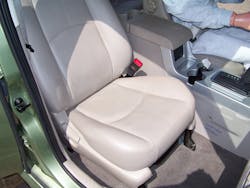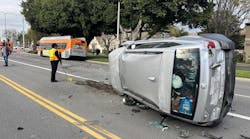Topic: Understanding SMART Seat Systems
Objective: The rescue team will better understand what exists inside a front passenger SMART seat of a late-model vehicle and what influence SMART seats have on responder safety.
Task: The rescue team shall cut apart the passenger front-seat cushion of a late-model acquired vehicle to uncover the various components of the SMART seat system.
When responding to a crash involving a late-model vehicle, it is likely that the passenger front seat is equipped with a built-in sensor system designed to detect whether the seat is occupied or not. We’ll refer to it as a SMART seat system.
If the seat is occupied during a frontal or off-angle frontal collision, the passenger front airbag and kneebag, if so equipped, will deploy. If no one is sitting in that seat when the impact occurs, those two front airbags will not deploy.
Although system designs vary, under normal conditions, a small indicator light on the instrument panel will illuminate, informing the driver that the passenger front airbags are either on or off.
What this means for rescue personnel is that both frontal airbags, and kneebags if present, will not necessarily deploy in a frontal collision as one might expect. It depends on whether the front passenger seat was occupied or not. A crew may find the driver’s airbag deployed and the passenger frontal airbag still loaded or undeployed. This can be a safety issue for rescue personnel.
Typically, the manufacturers state that their SMART seat will turn the passenger front airbag off if there is less than 65 pounds of weight on the passenger front seat. This weight criteria is a good average number, with most airbag cut-off weights ranging between 65 and 70 pounds.
A closer look
With the opportunity to dissect the passenger front seat of several 2017-model vehicles, we get a glimpse at what lies underneath the upholstery—something as rescuers don’t normally get to see.
Beneath the upholstery trim of the front seat lies a thin grid system. This grid, wired into the airbag electrical circuit, runs beneath the seat cushion as well as up the back of the seat. These dual grids silently sense if the passenger seat is occupied or not each time the vehicle is started.
There are also grid systems placed into seat cushions that can shut off seat-mounted side-impact airbags if the SMART seat detects that the passenger is “out-of-position” (i.e. leaning on the door as if sleeping). The special grid in the side-seat bolster cushion area actually senses continuity of the human body and shuts the seat airbag off if it thinks the occupant would be within the deployment zone of the seat airbag.
When a front seat has a built-in seat heater or cooling system, these features are located deeper in the seat cushion itself, beneath the SMART seat system. The seat heater on one passenger front seat we dissected consisted of a system of electrically heated elements positioned beneath the foam rubber seat cushion.
Dangers of the undeployed
Understanding that SMART seats may be present is good information for rescuers. What is most important though, is realizing that there is an undeployed passenger front airbag as well as a possible passenger kneebag. This can present a responder safety issue when a crew is working to jack or roll a dash, for example.
Crews need to agree that powering down the 12-volt electrical system on a crash-damaged vehicle is important. It minimizes the chance of unwanted airbag deployment during extrication, but does not eliminate the possibility.
We also need to train our rescue officers and crews to look for undeployed airbags when we are accomplishing extrication tasks—especially when on the passenger-side front dash area.






